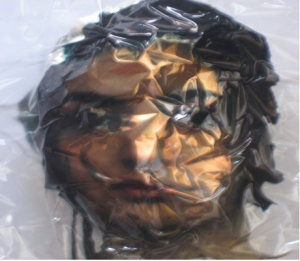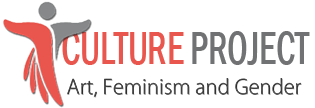4,562 Total views, 1 Views today
A reflection on the artwork of Avan Sidq…for Jina by Fiona Crouch
Some eyes haunt, staring directly from the canvases and TV screens. Other eyes are separated from their audiences by the plastic film that smothers their faces; a crumpled plastic film that can’t quite obscure the blood-red marks of violence that caused their deaths. And, some eyes have been created on acrylic: at first sight, these cartoonish lines seem joyful, until the expressions are read. This is the artwork of Avan Sidq – pieces that challenge and provoke an emotional response.

Avan Sidq was born in 1974 in Sulaymaniyah, in South Kurdistan/North Iraq. The city has a long tradition as Kurdistan’s capital of culture. After graduating from the Institute of Fine Arts in Sulaymaniyah, Avan fled to Germany as a refugee in 1997. She continued her education at the University of Johannes Gothenburg-Mainz, gaining honours in her postgraduate studies. As an artist, as well as founding the Concept Art group, Avan has shown her work in many countries; exhibitions have been held in Kurdistan, Germany, Austria, and Britain. Although she originally focused on painting, in time she diversified into experimenting in other mediums, including video art, installation, performance art, and photo installation.

I find it hard to tear myself away from the line drawing of a young person on a see-through acrylic screen. This image forms one layer of a multi-layered artwork: these are a young person strung up, man in red, man interjecting in front. Where should the viewer’s focus lie? Victim? Perpetrator? Audience? The choice of material captures my imagination – its transparency contrasts with the overall inscrutability of the artwork. The androgyny of the young person (with their hands above their head in surrender or as a sign of captivity) ensures that the figure embodies the stock representation of the everyman/everywoman. The man, who forms the next layer, is daubed in red paint: he has a sinister air. The red paint bears finger marks; he seems caught red-handed or streaked with his guilt. The layer nearest the camera features a man. Is he another everyman? Is he someone who is standing by silently watching or ignoring the hurt being done to the young person? The swirl of blue paint that seems to emanate from the man’s face and back again mirrors the mixed emotions I feel. Or does the blue represent the viewer’s silence, no words leaving his lips? Would I be brave enough to step in to stop another person’s suffering? Where does blame for atrocities lie – just the perpetrator or those who passively stand by, even when they could intervene?

Yet, for me, the most powerful piece shows a woman’s body in the abstract. There is real strength, something of the mythical Siren, oozing from the piece. Avan has created a celebration of womanhood. Its simplicity is striking, but impactful, with lacy, black underwear stretched across a frame – the shape of the stretched fabric hinting at the outline of full breasts, a nipple, a voluptuous torso and the shape of a thong. The use of textiles is sensuous and adds tactility and depth that could not be created by other materials. I feel guilty for labelling it as an artwork that is sexually themed. A woman should be able to celebrate her sexuality for herself, and not for a sexual partner or to conform with societal expectations. The piece is also a metaphor for the distorted reality that is our world: while the piece clearly represents a woman, it’s not quite realistic. The plain wooden frame that binds the artwork together prompted a number of questions in my mind. Is the piece constrained by the frame; perhaps symbolic of the ways in which women are subjugated by men and stereotypical concepts of womanhood? Or, perhaps Avan is highlighting how every woman is beautiful within if you look beyond the outside?
 From the lure of beguiling femininity to the ghoulish models of heads covered by plastic film or bags, Avan produces captivating pieces. The latter pieces remind me of South American shrunken heads; war trophies sealed within body bags[1]. It is interesting to note that there was an increase in inter-tribe killings when Western interest in shrunken heads stimulated demand. Through these pieces, is Avan signalling the atrocities that are still committed in the name of jingoistic aggression and aggrandisement aspirations, whether it is for land or resources? However, I can’t help thinking that the plastic film is akin to a macabre veil; thus bringing to mind the supposed ‘failure’ to properly wear a hijab that directly caused the death of Jina Amini. Jina was a young Kurdish woman, brutally killed at the hands of the brutal Iranian regime in Tehran, September 2022. She is our everywoman. That someone with her whole life ahead of her should needlessly die is tragic. The bravery demonstrated by the people of Iran to protest at her death is incredible. We can’t be silent; we shouldn’t be bystanders like in Avan’s multi-layered pieces, even if your only protest is to keep her name alive. When the purpose or value of art is questioned, the doubters must be nudged and reminded that art will always be a way of communicating messages and challenging the status quo; it can help coalesce disparate groups to develop a wider social consciousness. Avan’s work delivers this and more: her pieces are exquisite, and the messaging is subtle but sublime. Art is never just for art’s sake.
From the lure of beguiling femininity to the ghoulish models of heads covered by plastic film or bags, Avan produces captivating pieces. The latter pieces remind me of South American shrunken heads; war trophies sealed within body bags[1]. It is interesting to note that there was an increase in inter-tribe killings when Western interest in shrunken heads stimulated demand. Through these pieces, is Avan signalling the atrocities that are still committed in the name of jingoistic aggression and aggrandisement aspirations, whether it is for land or resources? However, I can’t help thinking that the plastic film is akin to a macabre veil; thus bringing to mind the supposed ‘failure’ to properly wear a hijab that directly caused the death of Jina Amini. Jina was a young Kurdish woman, brutally killed at the hands of the brutal Iranian regime in Tehran, September 2022. She is our everywoman. That someone with her whole life ahead of her should needlessly die is tragic. The bravery demonstrated by the people of Iran to protest at her death is incredible. We can’t be silent; we shouldn’t be bystanders like in Avan’s multi-layered pieces, even if your only protest is to keep her name alive. When the purpose or value of art is questioned, the doubters must be nudged and reminded that art will always be a way of communicating messages and challenging the status quo; it can help coalesce disparate groups to develop a wider social consciousness. Avan’s work delivers this and more: her pieces are exquisite, and the messaging is subtle but sublime. Art is never just for art’s sake.

This article is dedicated to the memory of Jina Amini and all protesters in Iran.
[1] Shrunken heads originally had greater religious significance for the peoples and tribes who practised this ritual. It is beyond the scope of this article to explore this more fully.

